India Policy Foundation webinar on "Brand Bharat"
Total Views |
India Policy Foundation webinar on
"Brand Bharat"
September 14, 2022
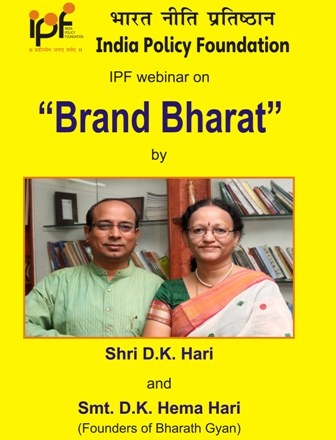
Speakers:
Shri D. K. Hari
Smt. D. K. Hema Hari
(Founders of Bharat Gyan)
Moderator:
Dr Kuldeep Ratnoo
(Director, India Policy Foundation)
Dr Kuldeep Ratnoo:
Namaskar! I welcome you all to today’s webinar on Brand Bharat. We are very lucky to have two eminent scholars and writers – Shri D.K. Hari and Smt. D.K. Hema Hari with us. It is great to have them here because they have done so much of research and so much of writing, they have been speaking on various issues concerning Bharat, our culture, our beliefs, our history etc. I am really grateful to both of them for having accepted my request to come to India Policy Foundation’s webinar and address us. I request our senior research associate Lekshmi Parameswaran to introduce both the speakers.
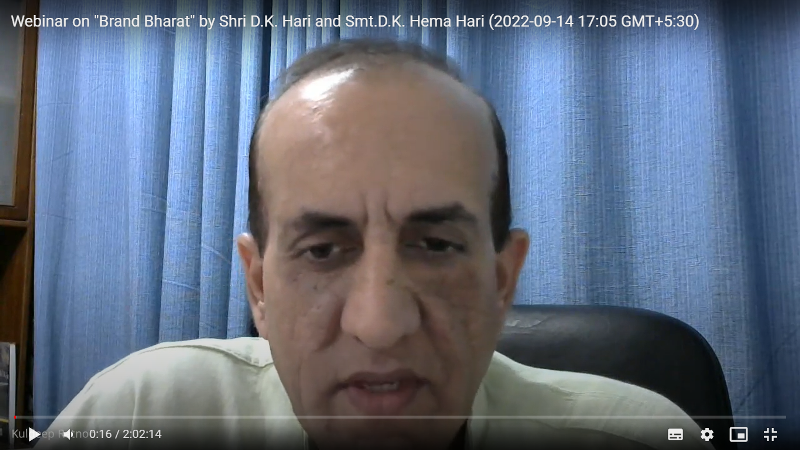
Lekshmi Parameswaran
Good evening, everyone! It is indeed a pleasure to introduce the power couple who have committed their lives to the pursuit of knowledge.
Dr. D.K. Hari and Dr. D.K. Hema Hari are the founders of Bharath Gyan, a civilizational study initiative to compile and present the knowledge of India and its ethos from an Indian perspective. An interesting fact is that they are management and IT professionals.
Dr. D.K. Hari hails from a traditional Indian family, with its roots in Kancheepuram. He did his schooling in Andhra Pradesh and graduated in Commerce from Madras Christian College, Chennai. He completed his post-graduation in Business Administration from P.S.G. College of Technology, Coimbatore.
He has over 20 years of industry experience in marketing, brand building and supply chain through family-owned businesses in Petroleum and FMCG verticals as well as from the Building Material industry.
Dr. D.K. Hema Hari is an IT professional turned researcher in Civilizational Studies. She was born in Mysore, grew up and was educated in Mumbai, got married and has settled down to live in Chennai with her husband in a joint family.
She graduated in Physics and later did her post-graduation in Computer Technology as a topper from Bombay University.
She is a PMI certified Project Management Professional with over 20 years of experience in the IT industry with the first 10 years at TCS and next 10 years at CSC India, focussed mainly on managing Innovation and nurturing new technologies for multinationals worldwide.
Both Dr. D.K. Hari and Dr. Hema Hari have travelled extensively to over 30 countries to understand those civilizations, their culture and knowledge. It was this exposure that motivated them to leave their lucrative professional careers and establish “Bharath Gyan” as an endeavour to fill the void in the showcasing of the knowledge, practices and culture of the Indian civilization across the millennia.
Their USP is the range and depth of data they present on the Indian civilization from the perspective of India and Indian ethos. They are also widely sought after as speakers on the Indian Civilization across India and the globe. They have given over 250 joint talks in India and abroad on diverse subjects. They have authored 27 books and produced 5 documentaries as well as many short films. They have published a monumental series called the “Autobiography of India” comprising many multi-volume titles, of which, 2 titles, spanning across 9 volumes have already been released. The first one in Brand Bharat and the other is Breaking the Myths.
The books in the Brand Bharat series include: Made in India, Roots in India, Unique to India, Leads from India and Future from India.
Dr. D.K. Hari and Dr. Heman Hari are also the recipients of several awards including the Shri. B.R. Haran Memorial Award and Visalakshi Award.
Thank you, Dr. Hari and Dr. Hema Hari, for finding the time to address today’s webinar. We look forward to an insightful and interesting discussion.
Dr. D.K. Hari and Dr. D.K. Hema Hari:
Dr. Hari: Thank you Dr Kuldeep for inviting us to speak in India Policy Foundation webinar.
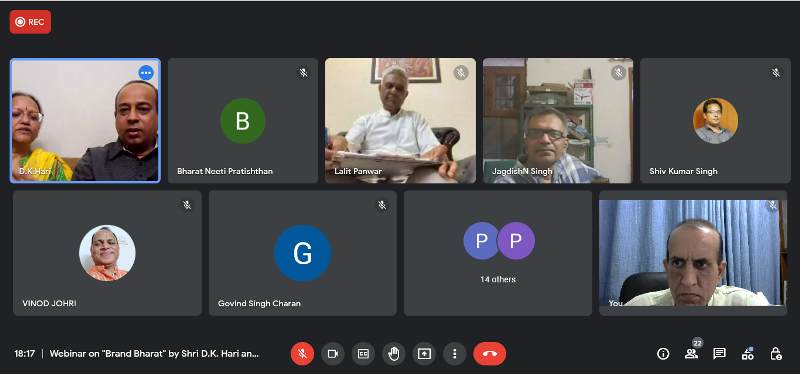
Getting on the subject of ‘Brand Bharat,’ the term itself is quite interesting. We all know land Bharat but the land Bharat is a brand by itself. What we have been doing in Bharat Gyan is to collate information on our civilisation and bring it out in a format, in a method that we can relate to in today’s generation. We have been doing it for 25 plus years. The methods that are easy for youngsters to assimilate and put to use. Otherwise, it is all there is some lofty books where people wouldn’t even step in or log in.
The idea is, Bharat is a brand by itself. If so, for what is it is a question that we need to ask ourselves. In our land, we say India that is, Bharat – just two names. The first question that comes to our mind is how did these two names come about? So, the north west of India, we have the Sindhu River which when the Persians and Arabs came 4000-5000 years back, in their language then, sa and ha were interchangeable. For them, Sindh became Hind. Now in Hindi, we have sari-sadi, Vengal-Bengal, Shukla-Shukra, etc. Like that, we had sa-ha. For the Persians and Arabs, Sindhu became Hind. For them, the land around the Sindhu River and beyond the Sindhu River became Hind. So, it is a name given to us by our neighbours.
If you look at the name Bharat, of course, we have lot of kings by the name Bharat, illustrious lineage of kings but for all of them what is the route? Bha denotes light, knowledge; Rata means immersed and Rati means delight. So, Bharatiya are the people seeking knowledge, relishing knowledge and discussing knowledge. Now, can we think of any other civilisation in the world calling themselves land of knowledge? You have land to the east of India, south, west, north, everywhere. Just pause for a moment and think of any of those names. You have England which comes from Englus/Engla Land. Then you have Germany, France, China but none of them call themselves land of knowledge. We have branded ourselves as the land of knowledge. Look at the beauty of it.
People to the west of our civilisation called us a geographical term, in their language, as Hind. If you look at the Chinese, they looked at the world from five perspectives. The Chinese called their king the King of Humans because they obeyed authority. The Turkish kings were Kings of Lions because they were courageous and ferocious. Persian kings were called Kings of Kings because they had fertile lands; Rome, King of Men due to their robust physique and beautiful faces. Indian kings were called Kings of Wisdom where knowledge and science were cultivated. This is two to three millennia ago. We calling ourselves is one thing, we branding ourselves is one thing but another civilisation whom we have had continuous ties across millennia also branding us the same, that is the beauty of it here. We are truly brand Bharat and Bharatiya. That is what we have shown in our slide and also in our book. (refer to ppt in the video)
Dr Hema Hari: The word Bharat, one where we have branded ourselves based on knowledge, because we relish knowledge, we have realised that this knowledge is of so many levels. At a physical level, if you see, the activities that we were engaged in also gave us the name Bharat. The word bha means glow – Bhaskara, Bhanumati, the rays of the sun etc. Now what is another activity which needs a lot of light, fire and glow? Metallurgy. It has been an activity of our civilisation for more than five thousand years and the evidence of this lies in what is called the Indus Valley Civilisation but it is the Sindhu-Saraswati Civilisation. When people study about India in western countries today, they think India means only Indus Valley Civilisation. But if you really look at it, the metallurgy and other such activities are spread all across India. These kinds of metallurgical activities needed lot of bhar or bhartan. The word for alloyed vessels, zinc especially in which we were excelling was bhartan. We use this word in Marathi and many other Indian languages. So, Bharat is also the land of metallurgy where there is so much of data to prove that the Bronze Age of this world has been fuelled by this civilisation.
Dr Hari: When we speak of historical periods – Stone Age, Ice Age, Iron Age, Bronze Age – you think these are all European. But you realise, the moment the world says Bronze Age, alloying is with us. There could have been no Bronze Age in the world itself without India providing the technology and the produce of bronze. Bronze Age in the world has got a huge brand of Bharat.
Dr Hema Hari: Literally if you look at it from a gross physical, geographic aspect also, Bharat means that which is enjoying the light of the sun. This land is very close to the equator, it is in the tropics, so by nature of its location, it enjoys the light. Now, there are so many other lands in this tropical zone, so what is so special about our land? Here, the beauty of this lies in the fact that it gets these seasonal annual monsoons and beautifully, we get these monsoons, after peak summer. Which means the summer is gone and you get your rains which is good enough for you to produce the agricultural output.
Dr Hari: Suppose the rains come before summer, you cannot produce. Here, the land is blessed with rain and sunshine in the sequence it needs to be. The sequencing is very important. So topographically also, we are right. We have light immersed in land of sunshine. We are uniquely and geographically placed. Etymologically, we have seen why we are Bharat. In literature, we have many kings called Bharat who relish knowledge.
Dr Hema Hari: Metallurgically we have seen how the name Bharat suits us. For climate, the latitude we are, Bharat suits us. From multiple angles, the people are seekers of knowledge. The brand name Bharat is apt for us in whichever direction you look at it. From all aspects, it seems to fit this land and all these reasons hold good and true at the same time.
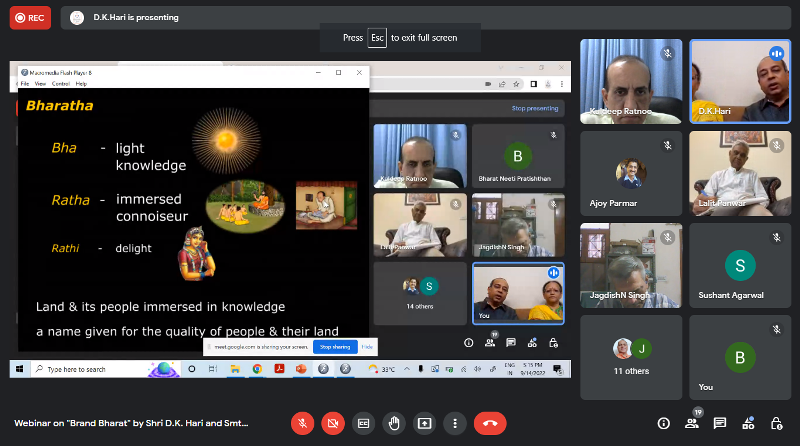
Dr Hari: We are not named after a quirk of history. We are not named after somebody who came to our land first by ship. The term America comes because there was person by the name Amerigo who went to that land by ship. Just because Vasco da Gama came, we are not calling our land Vasco. The way we have branded ourselves needs to be looked at from multiple perspectives – etymology, history, metallurgy, climate, people – it is a multi-layered name and holds good at each layer. That is the beauty of it. That is a naturally endowed name.
Dr Hema Hari: If you go through literature, you will find that in the Vedas, there is mention of this land and the people as bharatam janam. Vishwamitra tells that we are bharatam janam, people who are citizens of the land of Bharat.
Dr Hari: Look at how the naming for India happened by different civilisations.
Dr Hema Hari: We saw how the Persians referred to as Hind. The Persians and Greek have had a lot of contact. When this goes further to Europe, the H gets dropped and it becomes Ind – Inde- Indi. The Ind retains and it is retained in many forms. Finally, it goes to the English Islands and from there, it becomes India and that is how we started calling ourselves India. But the words Inde, Indi are there in European literature and their reference is from a very long time. This is not a new name because that is how they have known us for a long time. In fact, even if you go to the East, words like Tianzhu, Shendo, are morphed forms of the word, Hind Sindh etc. The Sindhu River has played a major role as all these people came from land across the Sindhu.
Dr Hari: We got Brand Bharat not just by name or knowledge, we did so by Big Five. If you go to Africa and speak about Big Five, they will speak about the animal game.
Dr Hema Hari: In Bharat, we have had another set of Big Five because this is what defined our brand for us.
Dr Hari: Look at the Big Five – 1) Iron and Steel 2) Cotton 3) Indigo 4) Sugar and 5) Spice.
Iron and steel are what we gave to the world across millennia. The Greek called Indian steel as onda nique. And hund wani was Indian steel. All others speak of it in glowing terms. The steel was what we gave to the world. The product was ‘wootz steel.’ Wootz is an angelical word because the English tongue or the English oral cavity could not pronounce it the way it was pronounced in India. For example, in the Tamil language, it is called urukku meaning to smelt. In Kannada, Telugu and Marathi, it is called ukku. King Saladin’s famous Damascus sword which is what you read all over medieval history is made from the urukku, ukku, wootz steel of Bharat. The Arabs were trading in our steel and sending it to Europe, they called it muhannad which means that which comes from Hind. When Chhatrapati Shivaji’s Maratha army and all other armies when they take a war cry or slash someone, they say Har Har Mahadev. The Persian way of slashing somebody’s body was called Jawabi Hind meaning I reply to you with an Indian made sword. So, the branding of Bharat happened in the steel. Wootz steel has layers of meaning to it. That is the beauty of it.
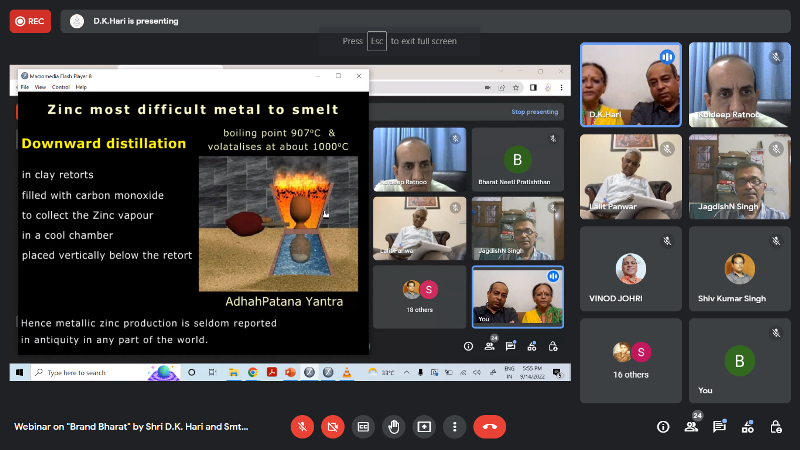
Dr Hema Hari: If you look at the word, Damascus, you will see that Damascus is a port in Syria. Damas means the wootz steel sword because they had wavy patterns on it. They were high carbon steel swords and therefore they had these wavy patterns. You can find them today in the Salar Jung Museum in Hyderabad. The word wavy in Arabian language is damas. That is why today, you have this brand for jewellery called D’damas to say that their designs are wavy and beautiful. Looking at the word, Damascus for the port, this was the port where swords from India would go and land. Initially the swords went, then they learnt the technique of making them. The whole of Syria as such is along the Mediterranean Sea.
Dr Hari: The whole of Mediterranean was supplied by Indian steel to Turkey, Egyptian empire, all from Damascus which was the centre of steel trade. The production happened in India, in the Malabar Coast, Konkan Coast, Coromandel Coast and ships were sent to reach the east coast of Mediterranean where it was the hub for this particular product. Steel was not just used for making your utensils but arms. What are you talking about then? India was the arms supplier of the world for five-six millennia.
Dr Hema Hari: It is very interesting. We have this brand of being a nation that has never gone to war. We have never gone and conquered like many other countries. We have had a few South-east Asian conquests; we do have far and few in history. But we are not branded as a nation that goes out on war. The steel that we have used has been used by many of these countries especially in Dark Ages for war.
Dr Hari: Steel is one of those products which we produced in bulk and supplied to the world in large scale. Aus B Hajr, a poet who lived in the sixth century described how these wavy patterns looked on wootz steel blade. When Alexander of Macedonia came to Bharat up to the Sindh River, Alexander did not ask for gold or silver from India. What he took was 100 Talents of wootz steel from India as a gift. Ktesias of Persia has recorded it in 326 BCE. We were exporting 10,000 ingots of wootz to Damas till they could make it on their own. This quality was first replicated in Sweden in 1774 by a chemist called Tobern Bergman and later was replicated in 1829. They could make this steel only 200 years ago. They could only replicate this in scale not quality.
The idea is that we have these production centres all over India, they are not limited to just one place. Even as late as the 17th century, Francis Buchanan has spoken about it. Having said this, what I want to bring out is if we are making steel in this range and quality and this particular expanse, what does it imply? England which was a steel producer had all the gold flowing to it. All the gold moved from India to Europe during the colonial times. Then, in the early 1900s, America became the steel producer of the world. So, all the gold started going to USA and it became a super power. Then post World War II, Japan and its Nippon Steel became the biggest iron and steel producer of the world. Japan by itself doesn’t have raw materials. Neither does it have coal, nor does it have iron ore. The coal and iron ore for Japan predominantly came from our Goa Coast. And Japan steel became famous.
Dr Hema Hari: So, we sent the ore, we sent all the raw materials to Japan and they produced and became the steel giants of the world and all the gold went to Japan.
Dr Hari: Post 1970, China became the steel producer of the world, so all the gold moved to China. Post 2020, if we once again, under the Make in Bharat program get to produce all the steel that the world needs, then the gold will move back to India after a gap of 200 years. Steel doesn’t follow gold; gold follows steel. So, if the brand of Bharat is steel, then the gold follows.
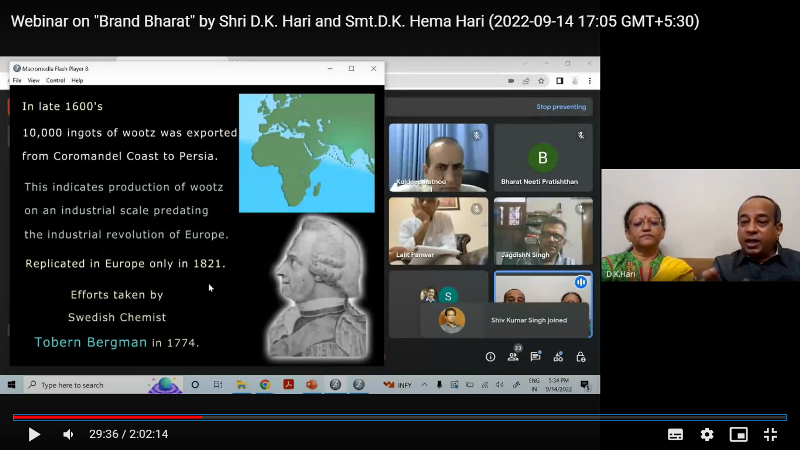
Dr Hema Hari: It is very interesting. We do not have a lot of gold mines in India but you find that for millennia, we have been having lot of gold reserves. Gold has been held precious here and we have valued it and saved it. Even today, we have a lot of gold with us because of our saving mentality. But where did we get all these gold from? It is fundamentally because of all this trade. It is the trade and especially with iron. In about 500 BCE or so, Herodotus writes in Greece that the iron arrow had sharp tips that is coming all the way from India.
Dr Hari: So, the battle fought between Greece and Macedonia called Thermopylae was fought with Indian iron arrowheads. Look at the brand that Bharat has been to the world. This is how India has been a brand to the world across times.
When Michael Faraday, we have all heard of him for having given us the concept of electricity, wanted iron and steel for fine filaments, he used wootz steel from India for his experiments on electricity. We were giving the hard product and also the soft product. So, when you say Brand Bharat, it was for the refined steel in the filament form and the hardest of the hard steel for fighting a battle. That was the range of products that we have had. We in India have also these iron pillars all over, right from Kollur to Delhi. So, one of the big five is iron and steel. We will do one more for paucity of time. Because of our exports of products, all the gold was being funnelled into India.
There is an argument between two steel swords. One is called the Excalibur of King Arthur of England. The sword belongs to King Richard, The Lion Hearted. Then you had the Damascus sword made of a Bharat steel, wootz steel. The discussion happens in a book called The Talisman written by Sir Walter Scott who was not favourable to India or Indic thought. But even he compares the two swords, he said, the Excalibur can break a stone into two but the Damascus can do even better. He says, throw a silk sash in the air and slash it with a Damascus sword, it can cut through silk sash in thin air which offers no resistance. That means it is a much higher quality steel. So, the quality of your Brand Bharat is discussed in Scotland, two centuries back by a person who is not favourable to India. He speaks about the Damascus sword made from Indian steel as being far superior to his own sword of the Excalibur. Look at the brand value that Bharat had across centuries and across seven seas.
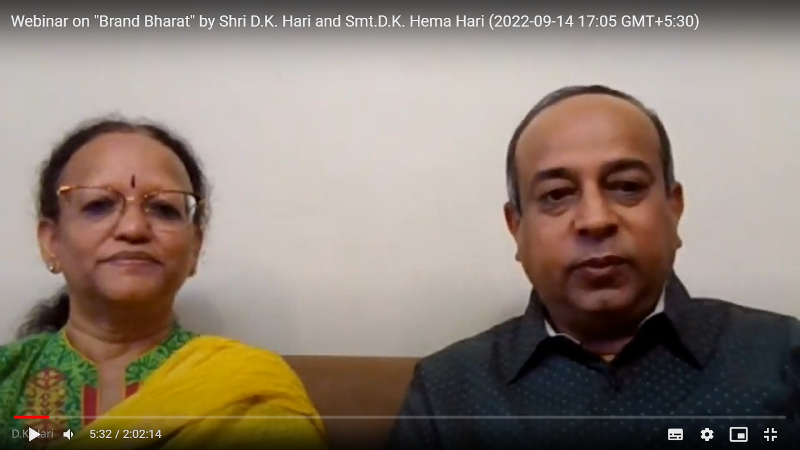
Dr Hema Hari: We have seen how D’damas has been a brand. So, this is very interesting. In Arabia, we have come across many women who are called Al Hend. If you ask them what is the meaning of their name, they said that it means somebody who is precious. The word hend, if you see is derived from the word hind, meaning that which is from Hind. In Arabia, Hind which means Brand India has been precious for so many millennia that it has become synonymous with precious. That is the kind of brand value that India has created with the Arab world. This is much before even Islam came into existence. For Arabia, India was a precious land and for India too, Arabia was a very precious trading partner.
Zinc is another interesting story which tells about India’s role in ushering in the Bronze Age. That also gives value to the brand name Bharat.
Dr Hari: Zinc is a very difficult metal to smelt.
Dr Hema Hari: Zinc is a metal that you will find it along with lead. The metal is such that it melts and then it vaporises very quickly, the window to find the liquid zinc is very short in terms of temperature. Because of this, the world was not able to get enough zinc. Now what did our Indian minds do? We turned the problem upside down. We kept the furnace on the top, put the zinc ore inside the retorts, made a hole at the bottom so that when the ore would get heated and start melting, through this hole, it would get captured in a retort at the base and this was kept in a cooling chamber. So, the vapours had no other way to go but only to come out through the small hole, they would get captured immediately in the cooling chamber and you would get very good quality zinc. Our method was very efficient.
Dr Hari: It is all about ingenuity of Brand Bharat in making a problem into a solution. The point is nobody else in the world could decipher this at all. We were making zinc from the Sindhu-Saraswati days. It was only in 1552 CE that the Ming dynasty in China came here and learnt how to make zinc. They called it totamu or tutenag because all along the Coromandel Coast, even now zinc production is called tutta nagam in Tamil, Telugu and other Indian languages. In Persian it is called tutiya, English call it, tutty and it is only in German that it is called zink. A person from Briston by name William Champion came to India but we didn’t give him the technology. So, he went to China, took the technology from there, went back to Bristol in 1752 to make for the first time, zinc was made in England and it came to be called tutty there. We held the way to manufacture zinc well over five millennia.
Dr Hema Hari: Now, you would ask what is so special about zinc? Why did the world need so much of zinc? Thing is when zinc combines with copper, you get brass. Similarly, copper with tin gives you bronze. This technique of alloying needs good metallurgical skills and that is what India had specialised in.
When the world speaks about civilisations, everybody will speak about China and the Silk Route which went from China to Europe. But there was an equal parallel Tin Route, much older by two millennia and this went from Hanoi in Southeast Asia to all the way to Haifa in Israel. The route was through India. Even today, 50 per cent of the world tin resources are in Southeast Asia. India played the role of supplying copper; it had a lot of cooper mines in Rajasthan. Copper would get fused as the alloys were made here and the alloying technique was perfected here. From here, the alloys were reaching the rest of the world. India was literally at the heart of the alloying technology, both in terms of producing and shipping the alloys as well as giving the skills for alloying.
Dr Hari: Silk is a product that went from India not just from China. Samples of silk were discovered that was a millennium before China.
Dr Hema Hari: It is a myth that silk originated in China alone. The samples show that it was a local variety of silk. Our silk worms were different.
Dr Hari: The other point I want to make is, you had a route of metallurgy which is more important than supplying silk. Because silk is a product that you can live with or live without. But without metallurgy you can’t live. You won’t be able to fight battles, you need your basic vessels and all that. We were actually supplying the most essential products a few millennia ago which is why we were called the Al Hend, the precious land. That was a brand of Bharat in multiple ways.
Dr Hema Hari: If you see, people have come searching for us. While we were called India, the lands around us that people came looking for were being called East Indies, West Indies and when they wrongly landed up in a land and they thought it was India, the people there came to be called Red Indians. Indonesia is also included in the list. All these names have come because people associated all this with India. The search was for India all over the world.
The western countries have this notion that at the end of the rainbow, there is a pot of gold. India was literally the pot of gold at the end of the rainbow and we have literally proudly showcased so many different brands – iron and steel, cotton, the colour blue, sugar etc. We made and sold ships to the world. Even today, the dhows are being made in Malabar. Vasco da Gama’s records also stated how the Indian ships were far superior. Then you have spice that people often associate Bharat with. All the softer knowledge has also gone from India. We have been a brand for both hard substances and softer knowledge.
Dr Ratnoo: Could you elaborate a little more on the soft knowledge part?
Dr Hari: Right from zero to infinity is what we discussed as soft knowledge. There is a book called Roots in India. We will take up certain aspects of it. We gave many things to the world like rhinoplasty, maths, sports, education, music, printing among others. A.L. Basham in his book, The Wonder That Was India, says that the “debt of the western world to India in the field of mathematics cannot be overestimated.” He added that most of the discoveries of the western world would have been impossible without the developed system of mathematics in India and the European system would have been shackled by the unwieldy system of roman numerals.
You simply cannot do any calculations using roman numerals. And who gave that?
Dr Hema Hari: If you look at the Gregorian calendar which we follow now, you have -1 or 1 BCE and after that, you have 1 CE. There is no zeroth year because there is no place for zero.
Dr Hari: They didn’t know such a number existed as recently as four hundred years ago whereas we had this from time immemorial. Today we have common era, that is in English. What do you call it in Indian languages? We call it samanya samvat in Hindi. For BCE, it is purva samanya samvat. So, the terminology should be created by us.
Dr Hema Hari: It is very interesting. We never had the need for such terminologies ever. Can you guess why? Because our calendar says 5100 years from Kaliyuga. We have had that as a marker and we have been counting forward from Kaliyuga. We did not have one historical figure whose birth we said, before him and after him. Today, we say time keeping is horology which comes from hora. This in turn comes from the Indian word, ahoratra which means cycle of day and night.
Dr Hari: The idea of horology is itself Brand Bharat. The Greeks don’t have an answer to where the word hora comes. We took the cojoined word’s central form and made it hora. The English word, ‘hour’ also comes from it. When you ask for soft power, this is the soft power. The important aspect of brand Bharat is three things – 1) We should know it. The problem is that we don’t know what are our brands.
Dr Hema Hari: 2) Once you know it, you have to own it. This has to be done by becoming part of your culture. 3) Once you claim it, you have to flaunt it.
Dr Hari: You start saying, it is your brand. If you don’t say that steel is your brand, others will say it is there in America, Japan etc. The very idea is we have been giving the best steel for the world. So, if you think of steel, you have to think with India in mind. Unless, you know it yourself, you will not own it. If you don’t own it, you cannot claim it or flaunt it. The first thing that comes is knowledge of what all are your products, what are your strengths and capabilities. That is what will give you an idea of brand Bharat – to know it, to own it and to flaunt it. Unless you do this, you will not have the full range with you. That is important. It is a combination of both hard power and soft power that creates the idea of brand Bharat over a period of time.
For those wanting to know more, we do conduct a certificate course on Indian thought and civilisation, the details are available on the Bharat Gyan website. Thank you so much for patiently listening to us.
Dr Ratnoo:
Thank you so much Dr Hari ji and Dr Hema ji. It is always a very difficult task to fill a vast ocean in a bucket. Considering the huge amount of knowledge that you have shared, on your website, through your books, through your programs, through your courses, that itself is humungous. What you have complied is almost like a five-year course in a university. We are extremely lucky to have you here and listen to the insightful points that you have raised in a very short time we have today. Now we open the Q&A session for the participants to ask questions to our learned speakers.
Q & A session
Amit Gupta: To my understanding, we had gold reserves because of international trade including spices, mineral, cotton and above all technology, i.e., manufacturing. Was it majorly for steel? Please elaborate.
Dr Hari: These are for all products. Cotton brought in a lot of gold, spices brought in a lot of gold. What I wanted to highlight was nobody speaks of steel bringing in a lot of gold, nobody talks about gold follows steel. Everybody thinks gold is a precious thing and we all go towards it. We are trying to bring a mind-set change point in you that wherever there is good quality steel, gold will follow it.
Dr Hema Hari: If you look at the quantity of it, trade of steel far outweighs, literally and metaphorically, the value of trade of cotton, dye or any other substance. Steel as such is far more valuable in the world. It was then and even today, the volumes that you have to trade in are also quite huge. That way, the amount of revenues that the trade of steel can bring in are very high and that has held good in the past. We are seeing how it has changed for other countries in the world as well and it is high time, we recognise that we do less of ore export but really do make the steel in India and start exporting steel and steel products to make sure that we can bring back a lot more of this value-added revenue back in our land. Today, we are exporting a lot of ore but we are not doing the value addition that we were doing earlier. Very interestingly, the value addition that we were giving, the technique of steel making that we had then, they have not reached that quality of steel even today. We had sustained production for so many millennia that means the way in which we were making which was a very decentralised way of not exploiting any one place too much, that kind of technique has always been quite effective and they still achieved industrial volumes of trade, production and all that.
If you go up a higher plane and start thinking, you realise that in India, you are creating deep holes of mines now and somewhere else, you are using that steel to make tall sky scrapers of steel. Instead of the very sustainable and decentralised ways of manufacturing that we followed earlier, this is a very lopsided approach. So, what can be done in the present times is food for thought.
Dr Ratnoo: That is very interesting because we all know how Goa was ruined due to export of iron ore, particularly to China. After Japan, if I remember, Korea also made a mark in steel production. Some of the big companies are Korean and they wanted to establish a plant in Odisha and that was opposed by us. Now we have realised that it is not wise to export your raw materials, it is always better to produce goods here and particularly in terms of good quality steel.
I also remember one interaction with some tribals in Jharkhand where their ancestors were making good quality equipment for construction and agriculture. Then big corporates in India started making those basic equipments and ruined the livelihoods of millions of people. They asked why should a company with hundreds of crores of turnover be permitted to make common equipment like fawda (spade) and ruin livelihoods of skilled tribals.
Gopal Parihar: This word, ahan is very important. In Patanjali’s Mahabhashya, he has divided all chapters from morning to evening – the entire day. Day means ahan. He has written 84 ahanika. So, all the words invented were interesting.
Aayushi Ketkar: I think it is very important for your work to reach the younger children. One of the things that is most often said about India and the Indic perspective is that we haven’t taken ownership. We think knowledge to be free flowing, unfortunately, in a knowledge economy, this is very important. What is the role of patents and copyrights when it comes to protecting Band Bharat? In international relations, there is a very important soft power concept. The soft power index does not have many intangible aspects when it comes to calculating the power of a nation and that is why we always see India lagging far behind when it comes to soft power. What suggestions do you have to give to scholars working to establish an Indian perspective in international relations?
Dr Hari: In India, oral tradition is limited only to the Vedas. Both our ithihasa, all our puranas, shastras, were all written traditions. We have mentioned 22 traditions of history keeping in our books. We have a clear written tradition going back two millennia and we have volumes and volumes of data of manuscripts in the traditional format. Less than eight per cent of the manuscripts that we possess have been touched by this generation and even translated. We are losing 90 plus per cent of manuscripts in our lifetime and in our generation itself.
The metrices of soft power have all been fixed by the West. We must change and include our parts in the larger matrix. It is becoming a multipolar world. We should know what we have, then own it and flaunt it. We are not doing it. A good forum to do this is an institution like India Policy Foundation where we know what are our strengths. In an event that we attended last week, a speaker from Belgium said that Antwerp owns the idea of diamonds. But they have owned diamonds only for 250 years, they did not know diamonds before that. Diamonds have been owned by us for the last 4000-5000 years and more. So, if we don’t say that diamond is an Indian product, it is an Indian idea, who will? Forget about what happened in the last 60-70 years, no use crying over spilt milk. Let us now put up our hand and say diamond is our product. If we don’t say it, it is our error. We must start owning what are our soft power to include it in the extended matrix. We have to know what are our strengths, list them out, own them and then expand the matrix. Then your soft power starts going up and others comes down to where it should be.
In our book, Future from India, we have mentioned that the world has gone through different eras. From 1600-1700, we went through transportation era, then we got into communication era. Then from 1900 onwards, we got into telecommunication era, internet era etc. From 2010, we are into knowledge era. In 2025-30, we will be in AI era. Once AI comes in and rules for about 10-15 years, humans and machines will be almost similar. Then what is the differentiating factor for humans. That will be the mind. Then the mind era will set in. When mind era sets in, which civilisation has researched maximum for the last 6000-7000 years? Our civilisation. So, if we don’t put up our hands and say that when the mind era comes in, come to us and we are ready with the knowledge, then you are a Vishwa Guru. You are not going to be a Vishwa Guru by following them in AI because 20 more countries are leading in AI along with India. To be a Vishwa Guru, we must get our act together. Our ancestors claimed the space of zero, now we must do the same to lead the era of the world. That is where institutions like India Policy Foundation have a huge role to play.
Piyush Pratap Singh: When we teach AI, we can prove that all the contextual grammar is ours. Semantic network is also ours. But there is no reference of artificial intelligence in the work of our ancestors. Have you found any reference?
Dr Hema Hari: I don’t think we should be looking for one on one match between then to now, especially on finer aspects of technology. Fundamentally, we can see that we have led and there is enough for us to explain the idea from the past, we should use that as our ground rule and our direction. There is so much of difference between now and then that we may not find the exact match. Across many Indian languages, you will find that semantically there are many common words which has kept the civilisation bound. If you go to the roots and etymology of any word, you will find that there is context and intelligence built into that. Today, we are relying on AI because we are trying to bring in a lot of machine intelligence. That was perhaps not the need then. And why it was not the need then is something worth pondering over.
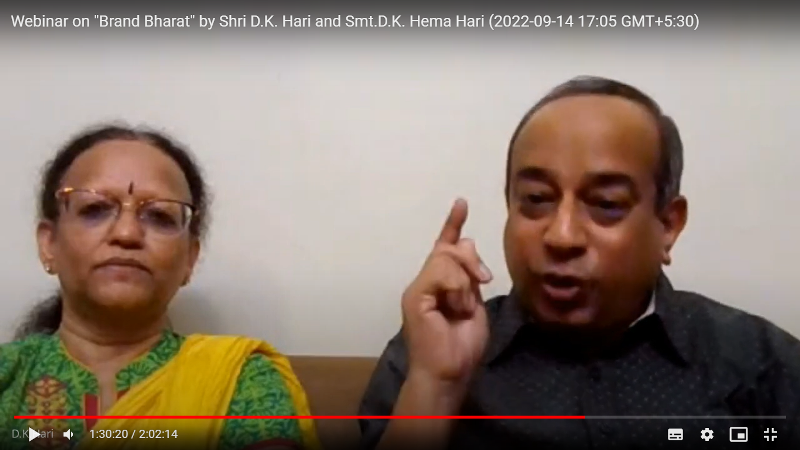
Dr Hari: Every word had a context in which the word was framed for us. When we look at the word nakshatra, we think it just means star. They are all naksha in the sky because they are mapping the sky for us.
Dr Hema Hari: The stars help navigation. Today we have grown in a mindset where we think that if we have to travel, the best time to travel is the daytime in the seas. But if you ask a good sailor, he will say that the best time to travel is in the night because that is when you have the skies and stars to give you the sense of direction. The thinking itself can be very different from then to now.
Dr Hari: Even the usage or prayoga of every word has a meaning to it. That is the speciality across languages. The samparka bhasa of Bharat, there is a union. All of them are intertwined languages.
Dr Hema Hari: They were all connected with activities of the civilisation. All of this comes from the innate Indian thought that the gross world comes from subtle. It is the sukshma which creates the sthula. The whole physical world gets created from the subtle aspects. If you want to understand the Indian civilisation, you have to go back to the thoughts and roots. It has to be something which comes as the ethos of the entire civilisation.
Dr Hari: The western thought doesn’t go beyond the sthula. Unless you go into the sukshma, there is a glass ceiling. And only Indians can fathom across the glass ceiling.
Dr Hema Hari: And that itself is a beautiful soft power. The soft power is hidden in our language. It is hidden in our traditions, practices, ethos etc. it is for us to slowly pull it out, harness and show it to the rest of the world.
Dr Hari: What can a historian do? He can travel across time in a dialogue whereas a physics or chemistry person will not do that. For AI, using the strength of our language, we are the ones who can travel from realms. Bharatiya minds can go from sukshma to sthula and back. You open up windows.
Piyush Pratap Singh: In the works of Plato and Aristotle, we find that they both were searching for intelligence beside human brain. Have we done something similar?
Dr Hema Hari: We find in all our Darshanas, that this is what we have precisely dealt with. We have addressed this as consciousness in the entire universe. The West has not yet named it. We have gone there and walked the path. We have six schools of thought which are among the subtlest and with pure logic you establish the consciousness. Then you come down to the Vedanta and the Gita, where you still talk about the overall consciousness in the entire world. We have recognised this consciousness and that is what our entire system of philosophy has been about. We have called it by different names like Purusha, Brahman etc. in different systems of philosophy. So, we have given it a good place and that is what we have to get back to and show that there is something more and beyond.
Lekshmi Parameswaran: You spoke about steel and zinc. As you rightly said, the technical knowhow of many of these products are lost. Is there enough research being done in India to revive such lost knowledge? For example, Bangladesh has been trying to revive Dacca Muslin for long now. Do we have such efforts happening in India?
Dr Hari: There are different types of products that we are trying to revive. Unfortunately, in the last two hundred years of colonial rule and before that the oppression, we have lost many of the good quality native produce. There is an effort to revive things like wootz steel which was not there many decades ago. When you say Dacca Muslin, in coastal Andhra Pradesh, there is a place called Machilipatanam. They had muslin.
Dr Hema Hari: In fact, the word, Machilipataman comes from the word, masulipataman. They were exporting all the muslin from the Coromandel coast.
Dr Hari: If you go to Kerala, there is a river called Chaliyar River from which you get the English words, shawl, saree. There again, you have to revive it. There are multiple efforts now. We have equally good muslins in other parts of India. Each of them has a distinct character. Somebody in the British wrote, Dacca Muslin is good, for him it is good but we have equally good muslins too. All of them have to be cumulatively revived. That should be the effort of the government and all the bodies. It has to be a multi-pronged effort.
Dr Kuldeep Ratnoo: At what stage of time did we lose respect for people who are into these very skilful activities? Whether they were ironsmiths, weavers, we started treating them as inferior. Was it external influence or was it loss of repute or relevance? Unless we recognise and give respect to that particular class which has skills, I don’t think we can go back to that stage again. What do you want to say about it?
Dr Hari: Obviously the few hundred years of onslaught followed by the colonial oppression obliterated many of this. Still, they are many who are doing it in their own way. But we should ensure that the skills are passed on to the next generation.
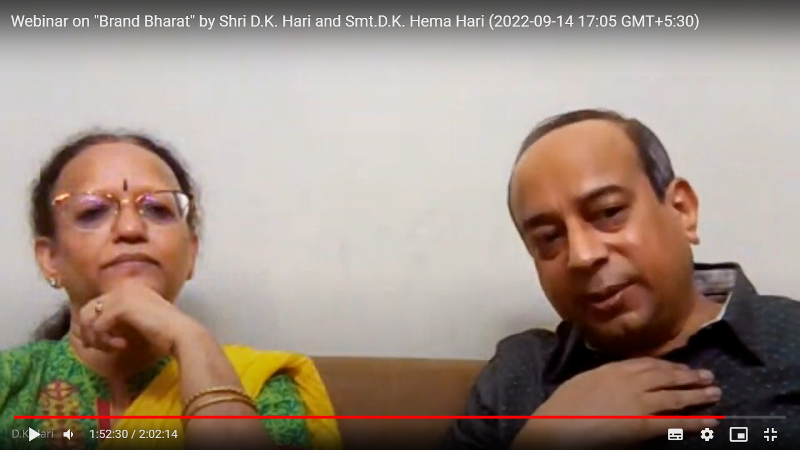
The world is coming to a view now that all these mega plants of any product alone is not enough. The idea is what Eric Schumacher said in the 1970s and 80s that small is beautiful. You don’t need products of only the mega mills. There is a place for them. You need both products and there is a market for both products. Today, the world is connected in a much better way, so encouraging them to be on the platform will be a big help. Skills they would have, but giving them encouragement and that little bit of assistance, will get them back on that mainstage platform and they will have their own place. I would not have made this statement with the same confidence probably 20-30 years ago. There is now space for all. The flattening of the world is happening in a way. All that they need to be given is that little bit of recognition, little bit of support and placing them on the platform is what is needed. Then there are a whole host of people who will again come back to the big stage. They have the capability and gumption to climb back. People genuinely want different products now; they no longer want only the machine manufactured products. We will have to give them the space.
Dr Kuldeep Ratnoo:
Thank you very much! It was great listening to you and knowing about the great work that you have been doing. Such huge canvas that you have put before yourself and now trying to find out the jewels from the vast Indian knowledge traditions for the benefit of our coming generations. As mentioned, the younger generation is taking interest in these subjects and they want to know more about it. That is something a matter of success and satisfaction. You spared time for us and spoke on diverse issues and answered all queries. So, on behalf of India Policy Foundation, I am extremely grateful to both of you. I am grateful to all the participants for taking interest and asking questions. Thank you very much for giving us time for such an enlightening talk.
To get access to the videos and books mentioned in the webinar, please visit: https://bharathgyan.com/

